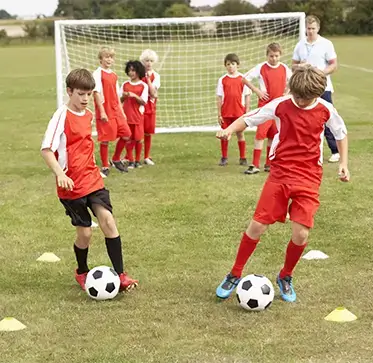CRFC BLOGS
LATEST BLOGS & NEWSLETTERS
The Ultimate Guide to Youth Soccer Positioning Drills
Positioning is one of the most critical aspects of the soccer game that young players must understand. Understanding where to be on the field, whether attacking or defending, is a skill that can make a significant difference in a player’s overall performance and the team’s success. This comprehensive guide explores the critical youth soccer positioning drills and strategies designed for various age groups, such as U8, U9, U10, and U12.
Why Positioning Matters in Youth Soccer
Positioning in soccer is much more than just standing in the right spot. It’s about understanding the game, reading the play, and working together as a team. Good positioning helps players cover the field effectively, making it difficult for opponents to find open spaces to exploit. It also helps maintain team shape, which is critical for attacking and defending.
Youth Soccer Positioning Drills
Lane Spacing and Separation Drill
The Lane Spacing and Separation Drill is an excellent starting point for teaching young players the importance of spacing on the field. The drill involves dividing the field into several lanes, which helps players understand their responsibilities in different areas of the field. Players learn to cover more ground by staying in their lanes and avoiding the common problem of bunching around the ball.
This drill is excellent for teaching the basics of positioning and instilling the concept of team shape. By maintaining their positions in the lanes, players develop an early understanding of keeping the team’s formation intact, which is crucial in defense and attack.
3-on-3 Multiple Goal Drill
The 3-on-3 Multiple Goal Drill is particularly effective for teaching positioning. In this drill, players compete in a small-sided game with multiple goals around the field. This setup forces them to think strategically about their positioning, as they must balance offense and defense while considering the numerous scoring opportunities.
This drill is fantastic for encouraging players to spread out and maintain awareness of their surroundings. It’s also a great way to introduce youth soccer drills to work on positioning in a game-like scenario, which makes it more relatable and more accessible for young players to understand.
Age-Specific Positioning Drills
Each age group has different developmental needs, so it’s essential to use drills appropriate for the player’s level of understanding and physical ability.
Youth Soccer Positioning Drills for U8
Stay-in-Your-Zone Drill
At the U8 level, players are beginning to understand the positioning concept. The Stay-in-Your-Zone Drill is designed to introduce them to this idea simply and straightforwardly. The drill involves setting up cones or markers to define specific areas on the field where players are expected to stay during the game.
This drill is essential for teaching young players to avoid chasing the ball all over the field, a common tendency at this age. By learning to stay in their zones, U8 players understand their roles and responsibilities within the team. These youth soccer drills for positioning lay the foundation for more advanced concepts especially during CRFC summer camps training as players progress.
Mini-Field Positional Awareness Game
Another effective drill for U8 players is the Mini-Field Positional Awareness Game. This drill involves playing a small-sided game on a reduced field size, which makes it easier for young players to understand their positioning relative to the ball and their teammates. The smaller field encourages more touches on the ball and helps players learn the importance of staying in their positions while actively participating.
This game-like drill is an excellent introduction to youth soccer drills that help with positioning. It combines the fun of playing soccer with the essential skill of understanding where to be on the field.
Youth Soccer Positioning Drills for U9
Positional Passing Drill
As players move up to U9, their understanding of the game improves, and they can start to grasp more complex positioning concepts. The Youth Soccer Positional Passing Drill is a great way to teach U9 players how their positioning affects passing and team play. In this drill, players practice passing the ball while maintaining their positions on the field.
This drill emphasizes the importance of being in the right place at the right time, which is critical for successful passing and ball movement. By focusing on positioning during passing drills, players understand how to create space for themselves and their teammates, a key component of youth soccer positioning strategies.
Positional Rotation Exercise
The Positional Rotation Exercise introduces U9 players to the concept of rotating positions, which is an important skill. This drill involves rotating players through different positions during a small-sided game, helping them learn how to cover for teammates and adapt to various situations on the field.
This drill is excellent for teaching flexibility in positioning and reinforcing that soccer is a team game where players must work together. These youth soccer drills for defensive positioning help players think one step ahead and prepare for various scenarios they might encounter during a match.
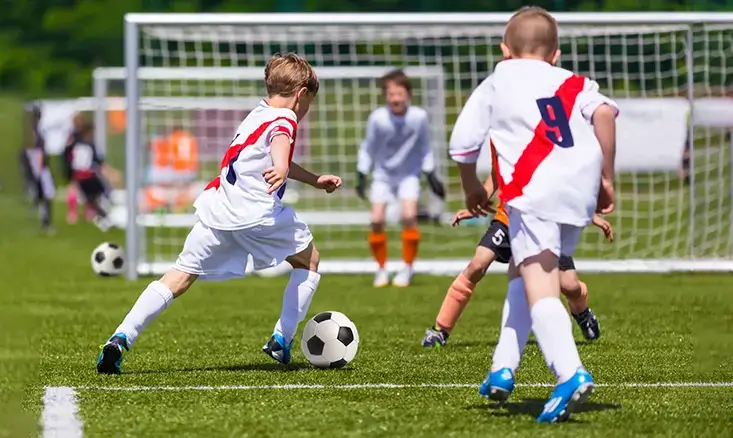
Youth Soccer Positioning Drills for U10
Zone Defense Drill
When players reach U10, they are ready to learn more advanced defensive concepts. The Zone Defense Drill teaches players to cover specific field areas rather than just following the ball. This drill is essential for developing defensive youth soccer positioning drills that focus on team defense and understanding how to protect the most vulnerable areas of the field.
In this drill, players are assigned to specific zones on the field and must defend their areas against attacking players. This helps them learn to work together as a defensive unit, covering for each other and maintaining the team’s shape even under pressure.
Width and Depth Drill
The Width and Depth Drill is another important exercise for U10 players. This drill emphasizes the importance of width and depth in maintaining the team’s formation. Players learn to spread out across the field, creating more passing options and making it harder for the opposing team to defend.
This drill is crucial for teaching players how to stretch the field, an essential aspect of attacking and defending. By maintaining proper width and depth, players can support each other better and create more space. The youth soccer formation drills incorporated in this drill help players understand the importance of staying organized and disciplined in their positioning.
Youth Soccer Positioning Drills for U12
Advanced Positional Play Drill
As players move into U12, they are ready for more advanced positioning concepts. The Advanced Positional Play Drill is designed to help players understand complex ideas like triangulation and support play. In this drill, players create passing triangles, essential for maintaining possession and building attacks.
This drill helps U12 players learn how to support their teammates by positioning themselves in a way that opens up passing options. These youth soccer drills to help with positioning prepare players for the more competitive and tactical aspects of soccer they will encounter as they progress.
Transition Positioning Drill
Transitioning from defense to attack (and vice versa) is a critical part of soccer, and U12 players need to be quick on their feet to handle these changes. The Transition Positioning Drill focuses on adjusting positions during these transitions, helping players maintain their team’s shape and structure.
This drill is critical for developing youth soccer drills for defensive positioning and offensive strategies. It teaches players to think ahead and be prepared to switch roles quickly, which is vital for success in more competitive games.
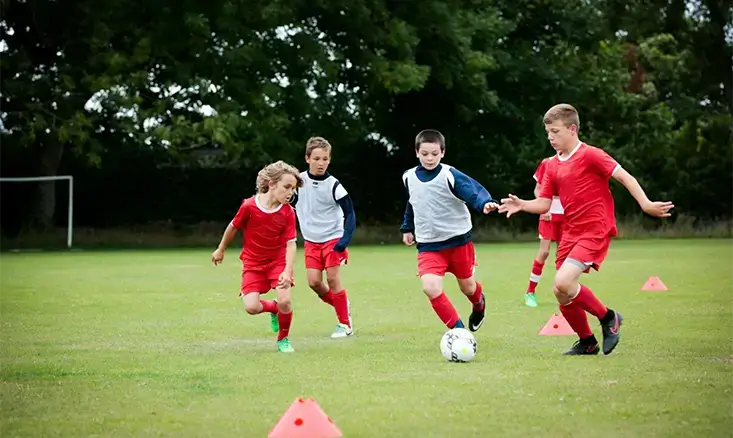
Youth Soccer Positioning Strategy Drills
Defensive Positioning Strategy Drill
Marking and Covering Drill
Marking and covering are fundamental skills in defense. The Marking and Covering Drill teaches players to stay close to their opponents while effectively covering the space. This drill is a core component of youth soccer defensive positioning drills and helps prevent the opposing team from finding accessible scoring opportunities.
In this drill, players practice marking their opponents tightly, making it difficult for them to receive the ball. At the same time, they learn to cover their teammates, ensuring that any gaps in the defense are quickly filled. This drill is essential for teaching the principles of team defense.
Pressure, Cover, and Balance Drill
The Pressure, Cover, and Balance Drill introduces players to three fundamental defensive principles. “Pressure” refers to applying pressure on the player with the ball, “cover” involves providing support for the player applying pressure, and “balance” ensures that the rest of the team is positioned correctly to deal with any threats.
This more advanced drill is suitable for U10 and U12 players. It teaches them how to work together as a defensive unit, applying these principles to maintain a solid defensive line. It’s necessary for teams looking to strengthen their youth soccer positioning strategies.
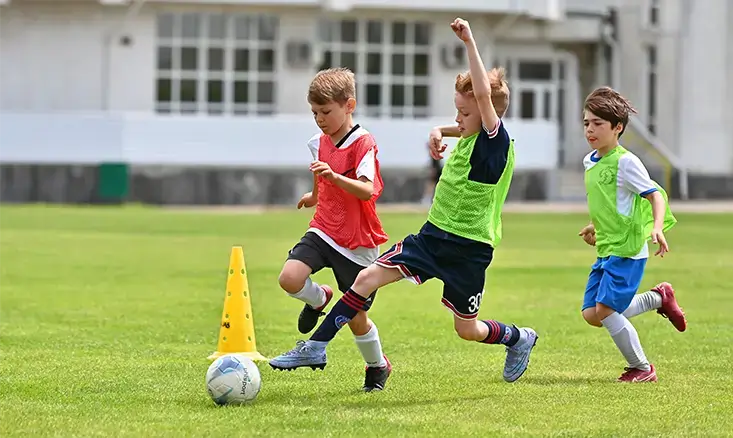
Offensive Positioning Strategy Drill
Finding Space Drill
On the offensive side, finding space is crucial for creating scoring opportunities. The Finding Space Drill helps players learn how to move into open spaces where they can receive the ball and make plays. This drill is an essential part of youth soccer drills to work on positioning in the attacking phase.
In this drill, players practice moving off the ball, finding space between defenders, and positioning themselves to receive a pass. This movement creates options for the player with the ball, making it harder for the defense to cover everyone. It’s an essential skill for any player looking to attack effectively.
Support Play and Positioning Drill
Support play is all about being available for your teammates. The Support Play and Positioning Drill focuses on positioning yourself to support the player with the ball, making it easier to maintain possession and advance up the field. This drill is a critical element of effective youth soccer positioning drills and teaches players the importance of teamwork.
In this drill, players practice supporting each other by positioning themselves in areas where they can receive a pass or provide a passing option. This drill emphasizes the importance of thinking ahead and being proactive in positioning, which is crucial for successful team play.
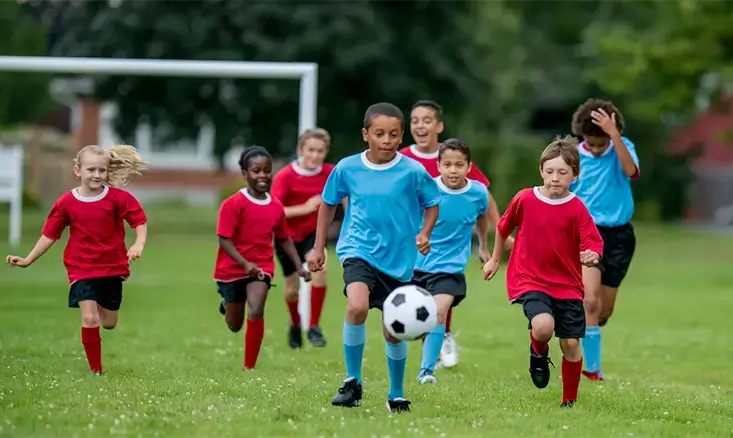
Conclusion
Positioning is the backbone of a well-organized soccer team. By incorporating age-appropriate drills and strategies, coaches can help young players develop the skills they need to succeed on the field. By focusing on positioning, young soccer players improve their skills and contribute to their team’s overall success.
FAQs
What are the best drills for teaching soccer positioning to young players?
The best drills focus on spacing and understanding zones, like the Lane Spacing and 3-on-3 Multiple Goal drills. These exercises help young soccer players learn where to be on the field and how to support their teammates.
How can I teach my U8 team to stay in their positions?
Start with simple drills like the Stay-in-Your-Zone drill, using cones to define areas. This helps U8 players learn the importance of staying in their space without chasing the ball everywhere.
What is the easiest way to explain positioning to U10 soccer players?
Use the Width and Depth drill to show how spreading out creates more space and passing options. It’s an easy way for U10 players to understand the importance of team shape.
How do you improve defensive positioning in youth soccer?
Focus on drills like Marking and Covering, which teach players to stay close to opponents while covering space. These drills help young players understand how to defend effectively as a team.
How can I encourage better spacing in my youth soccer team?
Use drills like the Lane Spacing drill, emphasizing maintaining positions and spreading out across the field. This helps players understand the importance of adequate spacing for better teamwork and passing.

Did you find this useful?


